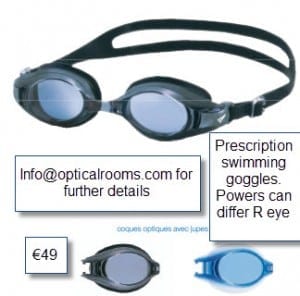Patients frequently ask us about swimming and contact lenses (CL). Their concern, and rightly so, is the effect of the water on their lenses and directly on their eyes.
Water contamination is a well-known fact and it is more a question of how much of a risk each environment potentially, has to contaminate your contact lenses and subsequently your eyes. River and lakes are certainly a higher risk environment than a chlorinated swimming pool. The sea due to its vast volume of circulating water is hazardous but the salt maybe more immediately problematic than any potential contamination issue.
Generally, people are referring to swimming pools, when they pose the question relating to swimming and their contact lenses. The reasons for concern are
a) the potential for chlorine contamination of their contact lenses and the subsequent discomfort it could cause and
b) the contamination of their contact lenses from the micro-organisms in the water that escaped the cleansing effects of the chlorine.
Removing contact lenses while swimming is an obvious fail safe method of minimising contaminating the eyes and removing the risk to your CL, lens case, solution bottle etc.
Prescription swimming googles are available with a wide expanse of powers to suit most prescriptions. While maybe not with perfect vision but certainly enough clarity to swim with and return to the correct changing room.
For those who want to swim with contact lenses I will briefly outline a study carried out in Australia in April 2011.
23 subjects were used to assess the risk of wearing contact lenses in a pool, some with, and some without swimming goggles. They also trialed 2 different common types of mass market CL. In an effort to asses if, what the contact lenses are made of, makes a difference. The older hydrogel material and the newer silicone hydrogel were sampled.
After a 30-minute swimming session, the CLs were gathered and assessed for their degree of contamination. Viable bacterial colonies were classified as gram negative or positive and enumerated. The consideration was the effects of the different types of CL material and whether the subject had worn goggles or not.
The resulting numbers of bacterial colonies indicated definitively and perhaps obviously that non-goggle wearing swimmers had a significantly large number of the bacterium than the goggle wearing swimmer. Interestingly there was no greater contamination of one CL material over another. The water sample from the pool indicated a much higher number of the bacterium than adhered to either CL. Indicating the contact lens material was not prone to contamination easily.
So we can conclude wearing goggles, if you are going to wear contact lenses while swimming, offers the best protection. While they do not remove risk from bacterial and chlorine contamination they certainly help to minimise it. A daily disposable contact lens, govern by the fact the wearer will be discarding the lenses, greatly reduces the risk factors.
Perhaps the best advice is to invest in some prescription swimming goggles. They are relatively inexpensive and elimate the risk of eye irritiation or infection. The eye it should be noted, is very resistant to infection with a very tough exterior, bacteria defeating enzymes with a copious tear supply, to flush out any foreign particles.
Using a pair of daily disposables for the swim and immediately discarding the contact lens is also an effective method, in reducing risk. It is proposed, few would stick to this discipline stringently but again it is an inexpensive option. Your optician could supply you with some daily disposable contact lenses for your hobby even if these were not your normal contact lens type or fitted into to your usual wearing schedule.

